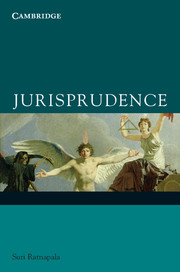Book contents
- Frontmatter
- Contents
- Acknowledgements
- List of Figures
- 1 Introduction
- PART 1 LAW AS IT IS
- PART 2 LAW AND MORALITY
- PART 3 SOCIAL DIMENSIONS OF LAW
- 7 Sociological Jurisprudence and Sociology of Law
- 8 Radical Jurisprudence: Challenges to Liberal Legal Theory
- 9 Economic Analysis of Law
- 10 Evolutionary Jurisprudence
- PART 4 RIGHTS AND JUSTICE
- References
- Index
8 - Radical Jurisprudence: Challenges to Liberal Legal Theory
from PART 3 - SOCIAL DIMENSIONS OF LAW
- Frontmatter
- Contents
- Acknowledgements
- List of Figures
- 1 Introduction
- PART 1 LAW AS IT IS
- PART 2 LAW AND MORALITY
- PART 3 SOCIAL DIMENSIONS OF LAW
- 7 Sociological Jurisprudence and Sociology of Law
- 8 Radical Jurisprudence: Challenges to Liberal Legal Theory
- 9 Economic Analysis of Law
- 10 Evolutionary Jurisprudence
- PART 4 RIGHTS AND JUSTICE
- References
- Index
Summary
The jurisprudential theories discussed in previous chapters, with the notable exception of the theory of Karl Marx, are cast within the intellectual tradition of political liberalism. There are significant differences among these theories, but they are ultimately grounded in liberal views of law and society. This chapter discusses the challenges to the fundamental assumptions of liberal legal theory that came to prominence during the later decades of the 20th century. It will focus in particular on the ideas of the critical legal studies (CLS) movement, postmodernist legal theory and feminist theory. It is not possible to understand criticism without knowing what is being criticised. Hence, I start with a brief discussion of liberalism and liberal legal theory.
Liberalism and liberal legal theory
Liberalism is a tradition in political and legal theory that gives primacy to individual liberty in the political and legal arrangements of a society. ‘Liberalism’ is a term of recent origin. Originators of the liberal philosophy such as Hobbes, Locke, Hume, Smith and Montesquieu did not use the word. In fact, ‘liberal’ in early English usage was a term of ridicule meaning a libertine. The term gained respect and influence during the 19th and 20th centuries and (in its various forms) has become the dominant political ideology of the Western world. There are many kinds of liberal theory, and important differences among them. The following questions draw different responses from liberal thinkers.
Why is individual liberty the pre-eminent political value?
What does individual liberty mean and what are its bounds and requirements?
[…]
- Type
- Chapter
- Information
- Jurisprudence , pp. 212 - 241Publisher: Cambridge University PressPrint publication year: 2009

